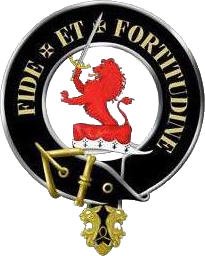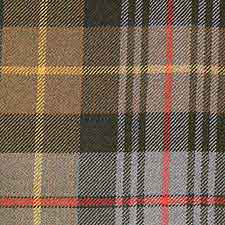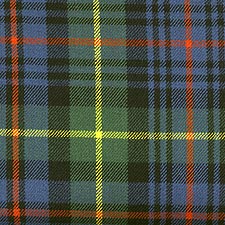CREST: On a chapeau, Gules furred Ermine, a demi-lion Gules holding in his dexter paw a sword. Proper.
MOTTO: Fide et Fortitudine: Fidelity and Fortitude
SEPTS: Barrie, Bowman, Brebner, Christie, Christison, Christy, Coates, Coats, Coutts, Cromar, Farquhar, Ferries, Findlay, Findlayson, Findlaison, Finlay, Finlayson, Gracie, Grassick, Greusach, Hardie, Hardy, Kellas, Kerracher, Leys, Lyon, MacArtney, MacCaig, MacCardney, MacCartney, MacCuaig, MacEaracher, MacErcher, MacErracher, MacFarquhar, MacHardie, MacHardy, MacKercher, MacKerracher, MacKindlay, MacKinlay, MacKinley, Paterson, Patterson, Reiach, Reoch, Riach, Tawse
The chiefs of the Clan Farquharson trace their ancestry back to Farquhar, fourth son of Alexander "Ciar" of Rothiemurchus. Alexander Shaw was the fifth chief of the Clan Shaw. His descendants took the name Farquharson. Another of Alexander's sons was Donald, who married Isobel Stewart, the heiress of Invercauld. Donald's son was Finla Mor who was the real progenitor of the clan. MacFionlaigh Mòr is the Scottish Gaelic patronymic. Finla Mor was the royal banner bearer at the Battle of Pinkie Cleugh in 1547 where he was killed. However he produced nine sons over two marriages from which the important cadet branches of the clan were sprung and the clan grew in stature. In 1595 the Clan Farquharson joined the Chattan Confederation and a bond of manrent acknowledged the chief of Clan Mackintosh, who was also chief of Clan Chattan as their "natyff cheiff". Towards the end of the 16th century the Clan Erskine chiefs set out to claim the Earldom of Mar but they were opposed by the increasing power of the Farquharsons. In 1628 Braemar Castle was built by John Erskine (Earl of Mar) as a bulwark against them, but in 1716 it fell into the hands of the Clan Farquharson. The clan became known as the fighting Farquharsons due to their fierce reputation and they became strong supporters of the Stuarts.
(From Wikipedia)
For a printable pdf of this information, click
HERE


